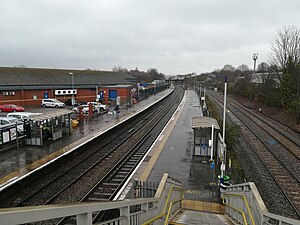 | |||||
| General information | |||||
| Location | Lawrence Hill, Bristol England | ||||
| Coordinates | 51°27′30″N 2°33′52″W / 51.4582°N 2.5644°W | ||||
| Grid reference | ST609734 | ||||
| Managed by | Great Western Railway | ||||
| Platforms | 2 | ||||
| Tracks | 4 | ||||
| Other information | |||||
| Station code | LWH | ||||
| Classification | DfT category F2 | ||||
| History | |||||
| Original company | Bristol and South Wales Union Railway | ||||
| Pre-grouping | Great Western Railway | ||||
| Post-grouping | Great Western Railway | ||||
| Key dates | |||||
| 8 September 1863 | Opened | ||||
| 1874 | Second platform opened | ||||
| 1891 | Third and fourth platforms opened | ||||
| 29 November 1965 | Closed to goods traffic | ||||
| Passengers | |||||
| 2018/19 | |||||
| 2019/20 | |||||
| 2020/21 | |||||
| 2021/22 | |||||
| 2022/23 | |||||
| |||||
Lawrence Hill railway station is on the Severn Beach Line and Cross Country Route, serving the inner-city districts of Easton and Lawrence Hill in Bristol, England. It is 1.0 mile (1.6 km) from Bristol Temple Meads. Its three letter station code is LWH. The station has two platforms, four running lines and minimal facilities. It is managed by Great Western Railway, the seventh company to be responsible for the station and the third franchise since privatisation in 1997. They provide all train services at the station, the standard service being two trains per hour along the Severn Beach Line and an hourly service between Bristol Temple Meads and Filton Abbey Wood.
The station was opened in 1863 by the Bristol and South Wales Union Railway, with a single track and platform. The line was doubled in 1874 when the Clifton Extension Railway opened, then expanded to four tracks and platforms in 1891. There were buildings on all platforms and a goods yard to the west. Service levels reduced significantly over the second half of the twentieth century. The goods facilities were closed in 1965, staff were withdrawn in 1967 and the eastern two platforms were taken out of service by 1974.
The line is due to be electrified as part of the 21st-century modernisation of the Great Western Main Line, which will also see the addition of two new running lines to increase capacity. Service frequency will be improved as part of the Greater Bristol Metro scheme.